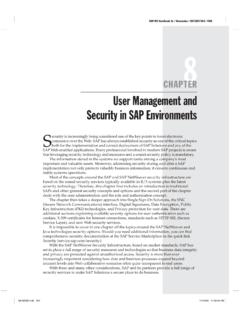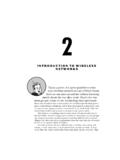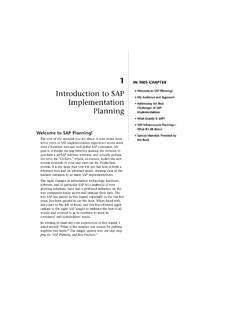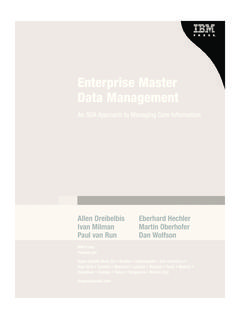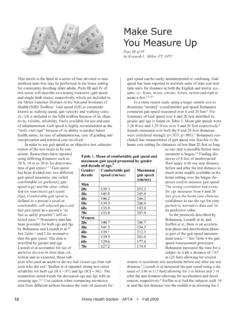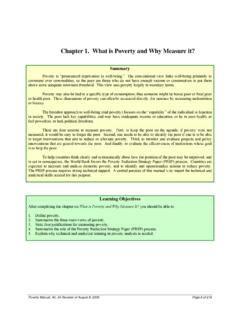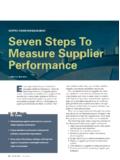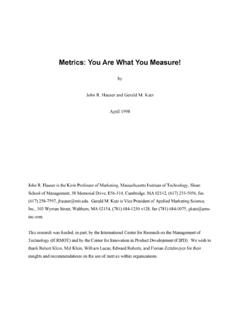Transcription of 03 0132300214 sect01 - cdn.ttgtmedia.com
1 1 Define- measure -Analyze-Improve-Control (DMAIC)Six Sigma s most common and well-known methodology is its problem-solvingDMAIC approach. This section overviews the methodology and its high-levelrequirements, given that the requirements define the appropriate deliverables,which dictate the tasks and the tool selection to aid in the task. This section alsooutlines the DMAIC standard toolset, through the understanding of the tool-task-deliverables linkage, to facilitate appropriate selection of a tool when refer-encing the how to tool articles in Part 2 of this Is the Main Objective of this Approach?The DMAIC (Define- measure -Analyze-Improve-Control) is the classic SixSigma problem-solving process. Traditionally, the approach is to be appliedto a problem with an existing, steady-state process or product and/orservice offering. Variation is the enemy variation from customer speci-fications in either a product or process is the primary can take on many forms.
2 DMAIC resolves issues of defectsor failures, deviation from a target, excess cost or time, and Sigma reduces variation within and across the value-adding steps in aprocess. DMAIC identifies key requirements, deliverables, tasks, andstandard tools for a project team to utilize when tackling a problem. Brief Description of DMAIC ApplicationsThis classic or traditional Six Sigma methodology was designed to solve aproblematic process or product and/or service offering to regain addresses improvements in productivity (how many), financial (howmuch money), quality (how well) and time (how fast) PFQT. Originallycosts dominated the financial aspects, but lately project focus has shifted1303 6/27/07 12:17 PM Page 13to revenues and growth. The 5-step DMAIC [pronounced duh-MAY-ick ]method often is called the process improvementmethodology. The classic strategy reduces process variance (in total, across the activ-ities and within-step) to bring it back on target the customer specifica-tion or requirement.
3 Knowing that Six Sigma resolves more issues thanjust cycle time, Figure 1-1 highlights its impact on cycle time by contrast-ing a problematic process versus its post-Six Sigma improved (DMAIC)14 ProblematicProcessStep 1 Step 2 Step 3 Step 4 ProcessAfterSix SigmaStep 1 Step 2 Step 3 Step 4 Cycle TimeFigure 1-1:Six Sigma s Impact on Cycle TimeThe DMAIC approach is designed to allow for flexibility and iterative-work, if necessary. As more is learned through the 5-step process,assumptions or hypotheses as to the root cause of the problem may bedisproved, requiring the project team to revisit them and modify or toexplore alternative possibilities. For example, root cause to a sales forceeffectiveness issue may have been hypothesized as a sales training prob-lem in a specific geographic region. Rather than jumping to conclusionswithout facts by implementing a new sales training program, the SixSigma project team wisely decides to gather facts about the problem some investigation and analysis, the team discovers that the rootcause points to an issue with sales management direction, not lack ofsales representatives knowledge and skills.
4 If the project team actedupon the original assumption, time and money would have been wastedon developing a mismatched solution that would have produced poorresults; the team s hard work would have gone to waste. Instead, theteam did a mid-course correction based on facts, adjusted its hypothesis,and developed a solution directly aimed at the true root cause hencefavorable results ensued. DMAIC builds on three fundamental principles: Results-focused; driven by data, facts, and metrics. Work is project-based (short-term in nature, with length dependingon scope and complexity) and project-structured, versus an 6/27/07 12:17 PM Page 14 Inherent combination of tools-tasks-deliverableslinkage thatvaries by step in the DMAIC methodology uses a process-step structure. Steps generallyare sequential; however, some activities from various steps may occurconcurrently or may be iterative. Deliverables for a given step must becompleted prior to formal gate review approval.
5 Step Reviews do occursequentially. The DMAIC five steps are Step the problem and scope the work effort of the description of the problem should include the painfelt by the customer and/or business as well as how long theissue has existed. Hence, identify the customer(s), the projectgoals, and timeframe for appropriate types of problems have unlimited scope andscale, from employee problems to issues with the productionprocess or advertising. Regardless of the type of problem, itshould be systemic part of an existing, steady-state processwherein the problem is not a one-time event, but has causedpain for a couple of current process or whatdata is available and from what source. Develop a plan to gatherit. Gather the data and summarize it, telling a story to describethe problem. This usually involves utilization of graphical tools. Step current performance to isolate the analysis (both statistical and qualitatively), begin to for-mulate and test hypotheses about the root cause of the problem by selecting a on theidentified root cause(s) in the prior step, directly address thecause with an improvement.
6 Brainstorm potential solutions, pri-oritize them based on customer requirements, make a selection,and test to see if the solution resolves the improved process or product performance toensure the target(s) are the solution has resolved theproblem, the improvements must be standardized and sustainedover time. The standard-operating-procedures may require revi-sion, and a control plan should be put in place to monitor ongo-ing performance. The project team transitions the standardizedimprovements and sustaining control plan to the process playersand closes out the DMAIC project typically runs for a relatively short duration (three tonine months), versus product development projects (using UAPL orDFSS) and operational line management (using LMAD), which can runBrief Description of DMAIC Applications15 DMAIC03 6/27/07 12:17 PM Page 15years. Given the relatively shorter duration to other types of Six Sigmamethodologies, we distinguish the DMAIC as having five steps, ratherthan phases.
7 The DMAIC method is primarily based on the application of statisticalprocess control, quality tools, and process capability analysis; it is notaproduct development methodology. It can be used to help redesign aprocess any process, given that the redesign fixes the initial processproblem. To be implemented, the method requires four components: Ameasurement system(a gauge) of the process or product/serviceoffering in trouble. Standard toolsetthat supports tasks to produce deliverables(including statistical, graphical, and qualitative tools andtechniques). An ability to define an adjustment factor(s)to correct the process orproduct/service offering back on target. A control schemeto maintain the improvement or correction overtime by implementing a control plan with a monitoring system toaudit the response performance against statistical control limits anddefined action plans if Key Overall Requirements Define this Approach?Requirements come from the customer and the business, depending onthe problem scenario.
8 The (internal and external) customer requirementsget translated into what iscritical-to-quality(CTQ). These CTQs define thecriteria to evaluate what good looks like how well the project scope anddeliverables meet requirements. Hence, the project team must meet therequirements of a phase before declaring completion and closing it out. The DMAIC method was designed and structured to answer the fol-lowing overall business questions: What does the customer define as the problem? (Secondarily, is the problem sustained over time, is it chronic, or is ita one-time occurrence?) What characterizes the current problem ( , process and perform-ance metrics), and how has it changed over time? (Secondarily, is the process in control, and does it have a good meas-urement system? Is the process capable of producing the customerrequirements?)Define- measure -Ana lyze-Improve-Control (DMAIC)1603 6/27/07 12:17 PM Page 16 What are the root causes, and what improvement actions correctthem to meet customer requirements again?
9 (Secondarily, is the process capable of producing the customerrequirements?) What controls should be implemented to sustain this improvement,including a warning system, action plan, and communication planneeded in case requirements fail to be met? (Secondarily, can the improvements be sustained over time?)What Requirement Determines the Key Activities in thisApproach?The preceding key business questions determine the DMAIC 1-2 depicts a high-level process flow of the DMAIC methodthrough its five Requirement Determines the Key Activities in this Approach?17 DMAICD efineClose ProjectNoMeasureAnalyzeImproveControlInC ontrol?Goodmeasurementsystem?RemoveMeasu rementSystem variationYe sNoNoYe sProcessCapable?Close ProjectProcessCapable?SustainedImproveme nt?Ye sYe sClose ProjectNoYesYe sNoNoRemoveKnownSpecialCausesProblemover -time?Figure 1-2: High-Level DMAIC Process FlowTable 1-1 shows the linkage between the high-level business require-ments and the five-step DMAIC method.
10 03 6/27/07 12:17 PM Page 17 Table 1-1: DMAIC Requirements-Step LinkageRequirementsResulting High Level Task (Step)What does the customer 1. DEFINE define as the problem? Describe in the words of the external orinternal customer Voice of Customer(VOC). Define the boundary conditions set forthby the business, including regulatoryenvironment Voice of Business (VOB). Understand the current process. What hashappened over time, examine processcontrol charts to identify incidents ofcommon and special cause variation Voice of the Process (VOP).What characterizes the 2. measure current problem (that is, measure the problem; describe it with process and performancefacts, data, and performance metrics. metrics), and how has itDetermine if the process in control and if changed over-time?the measurement system is accurate. Considered iterative until metrics aregathered over are the root causes?3. ANALYZED etermine if the process capable of pro-ducing the customer requirements.

